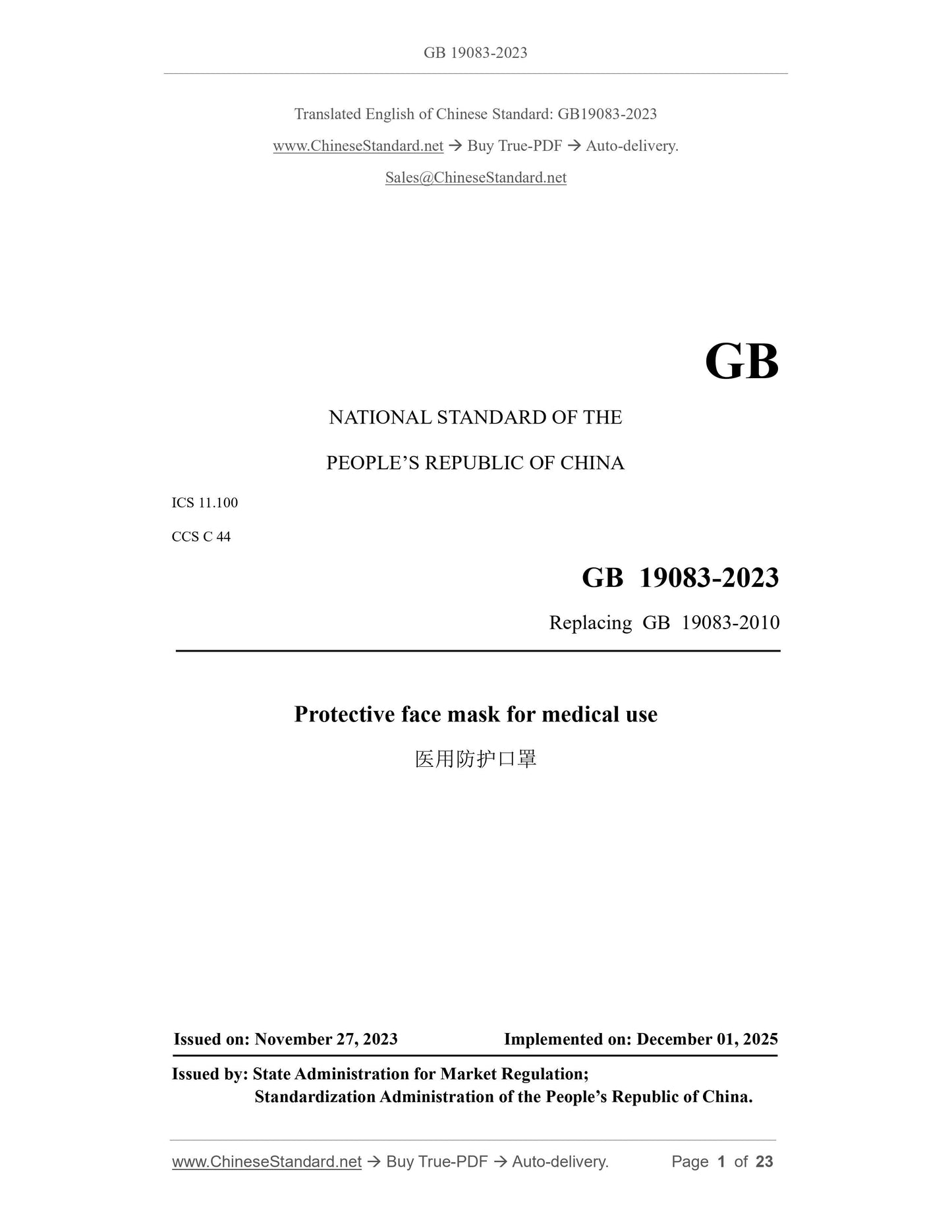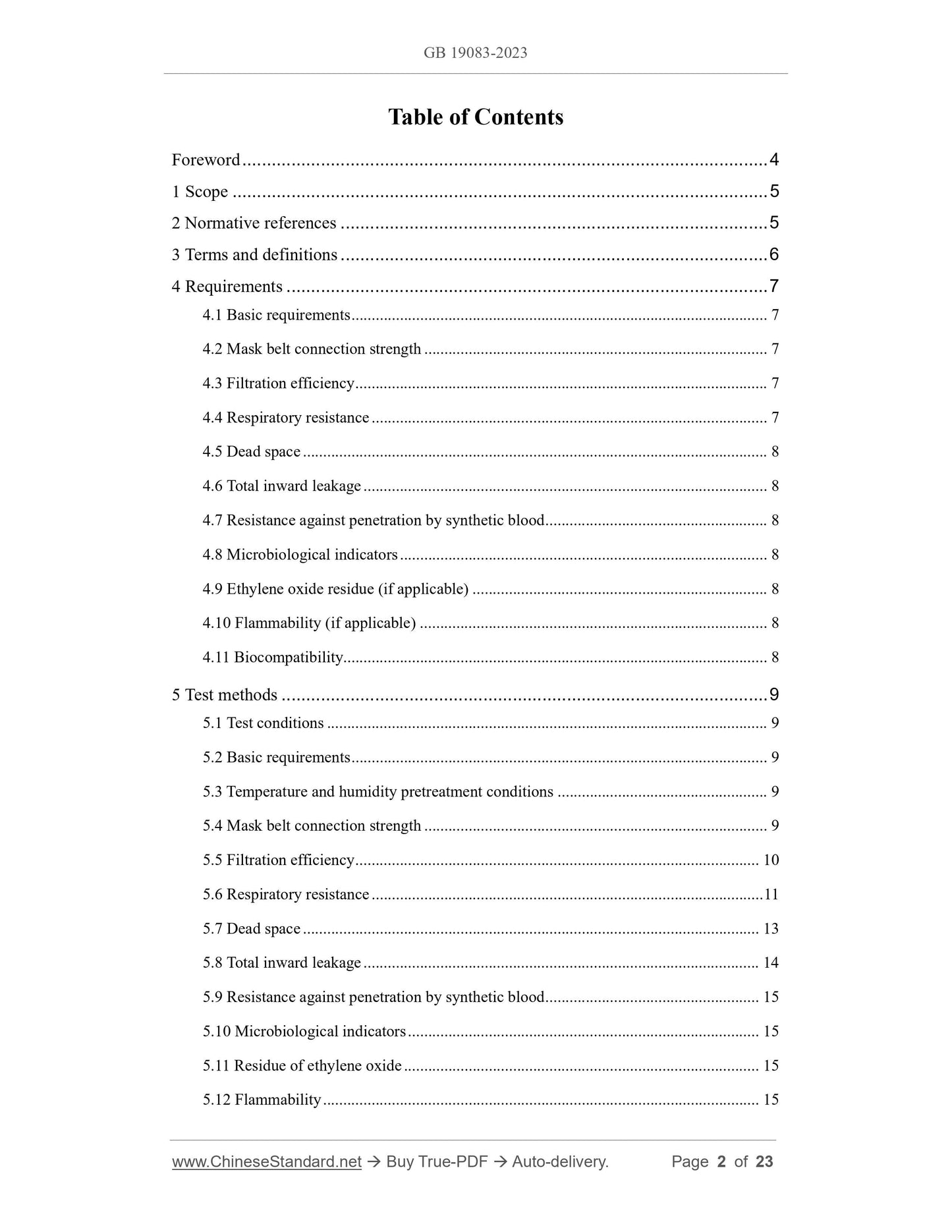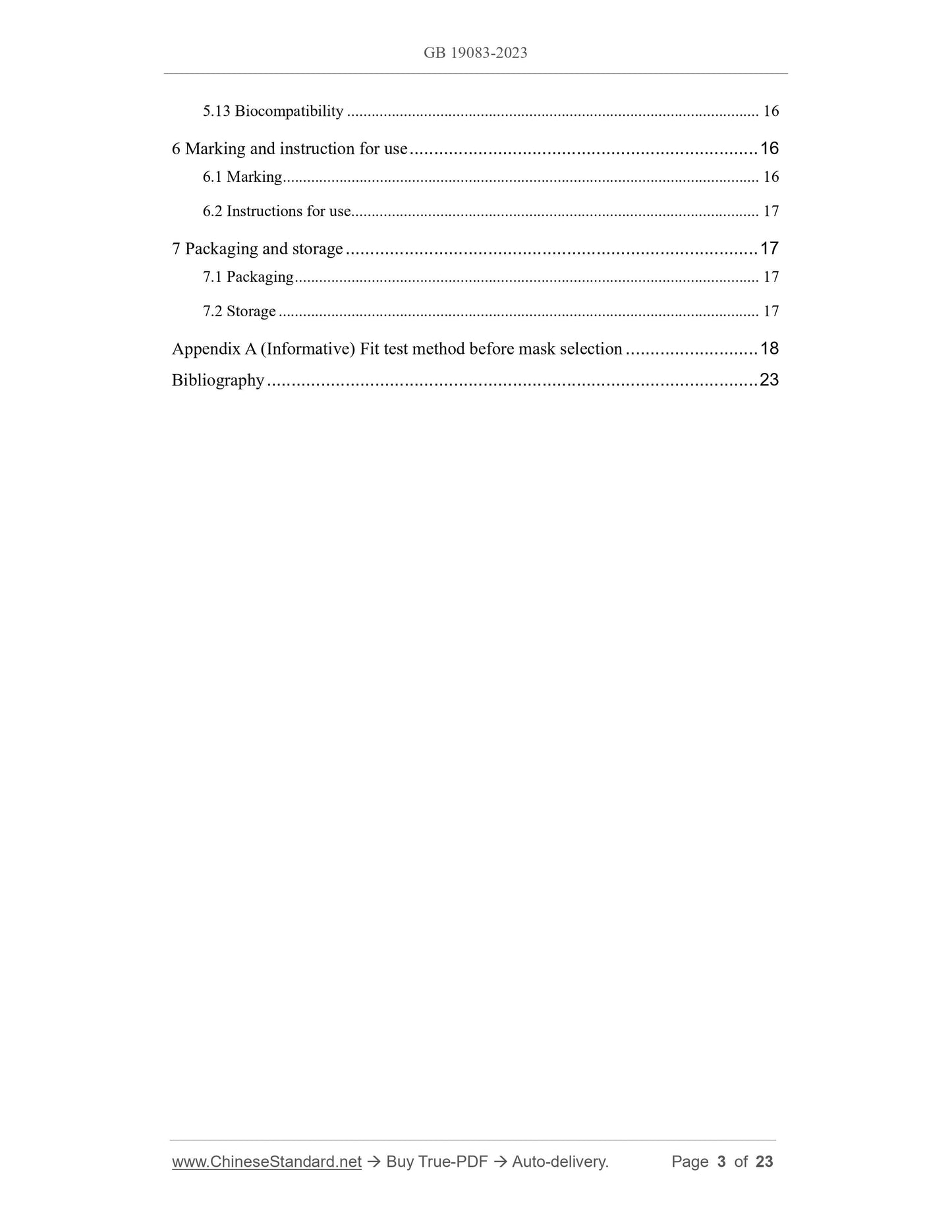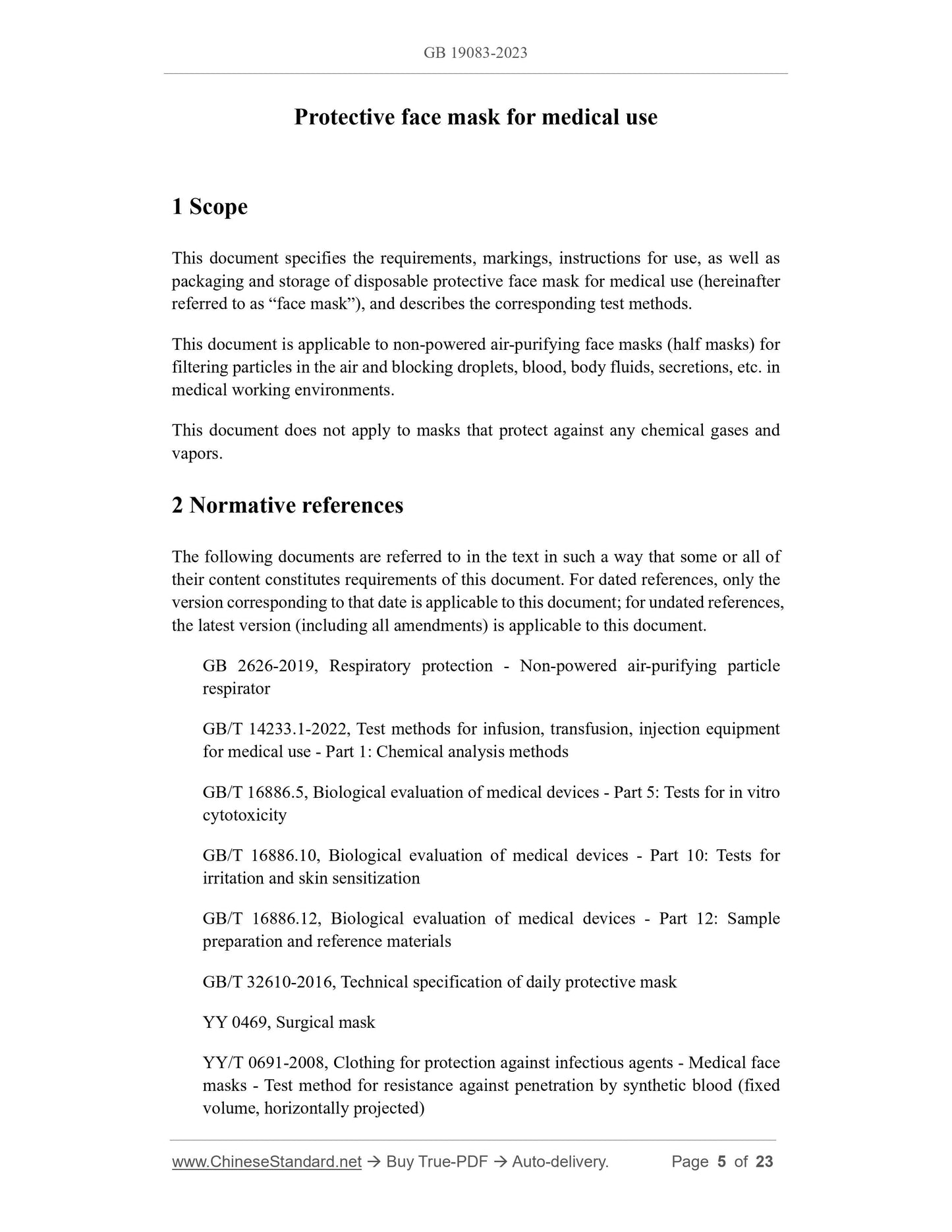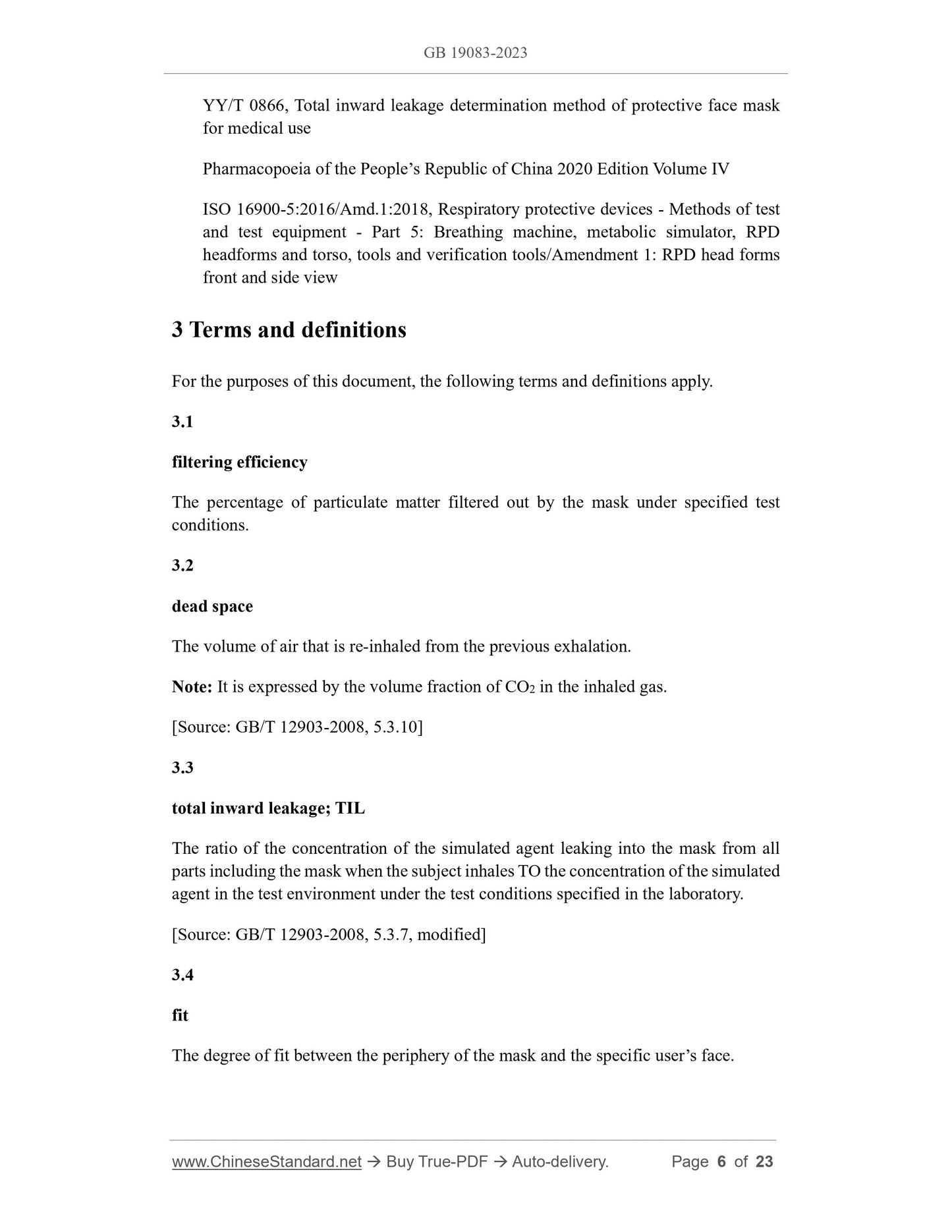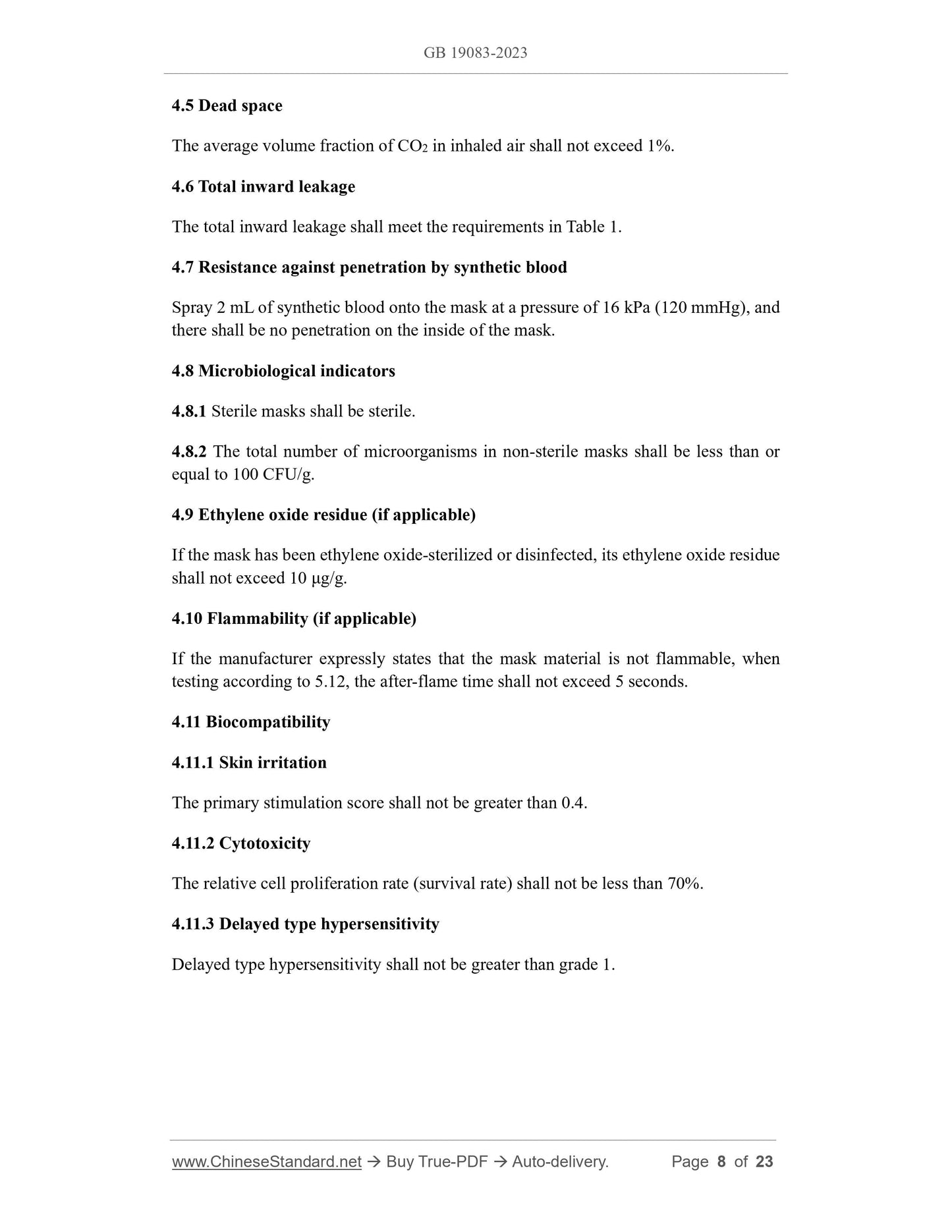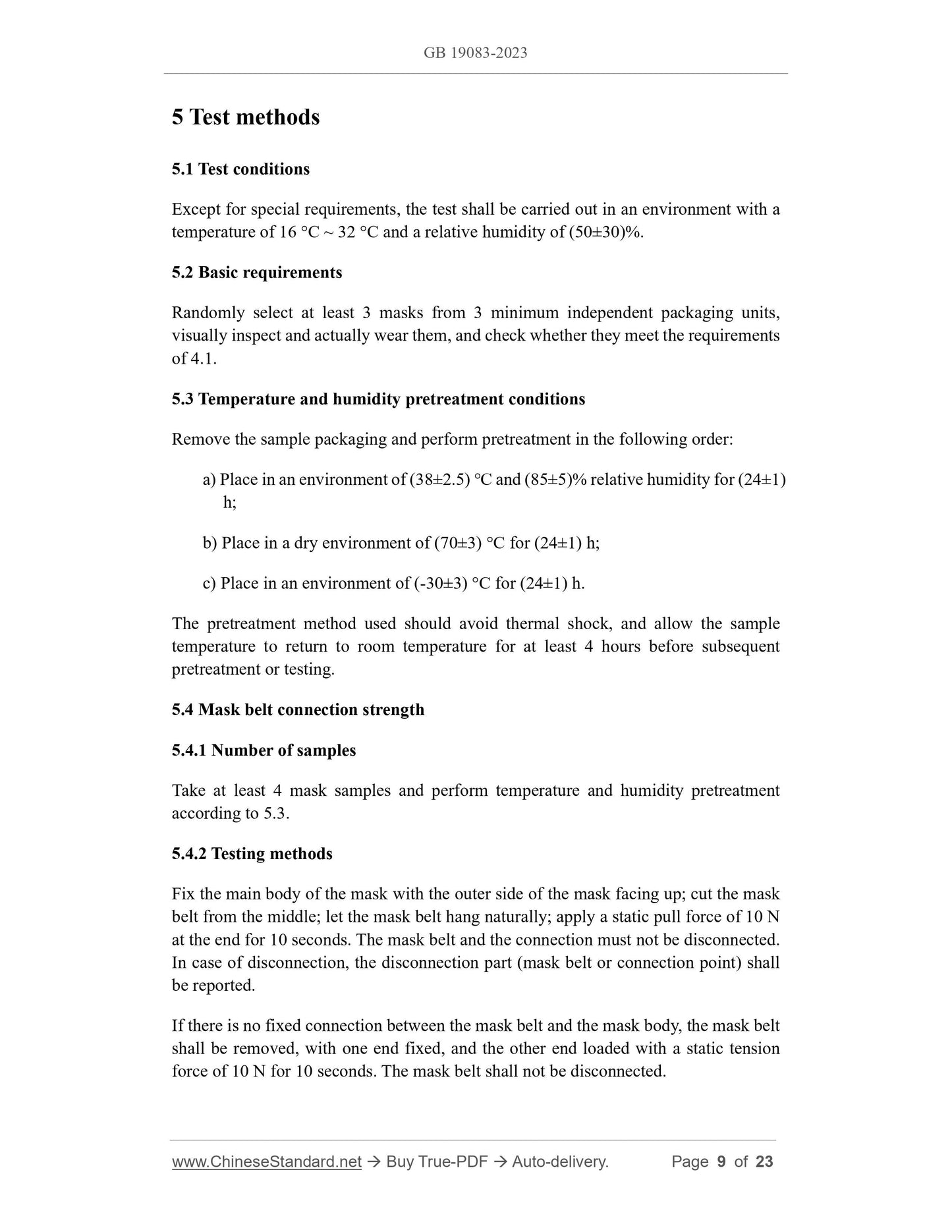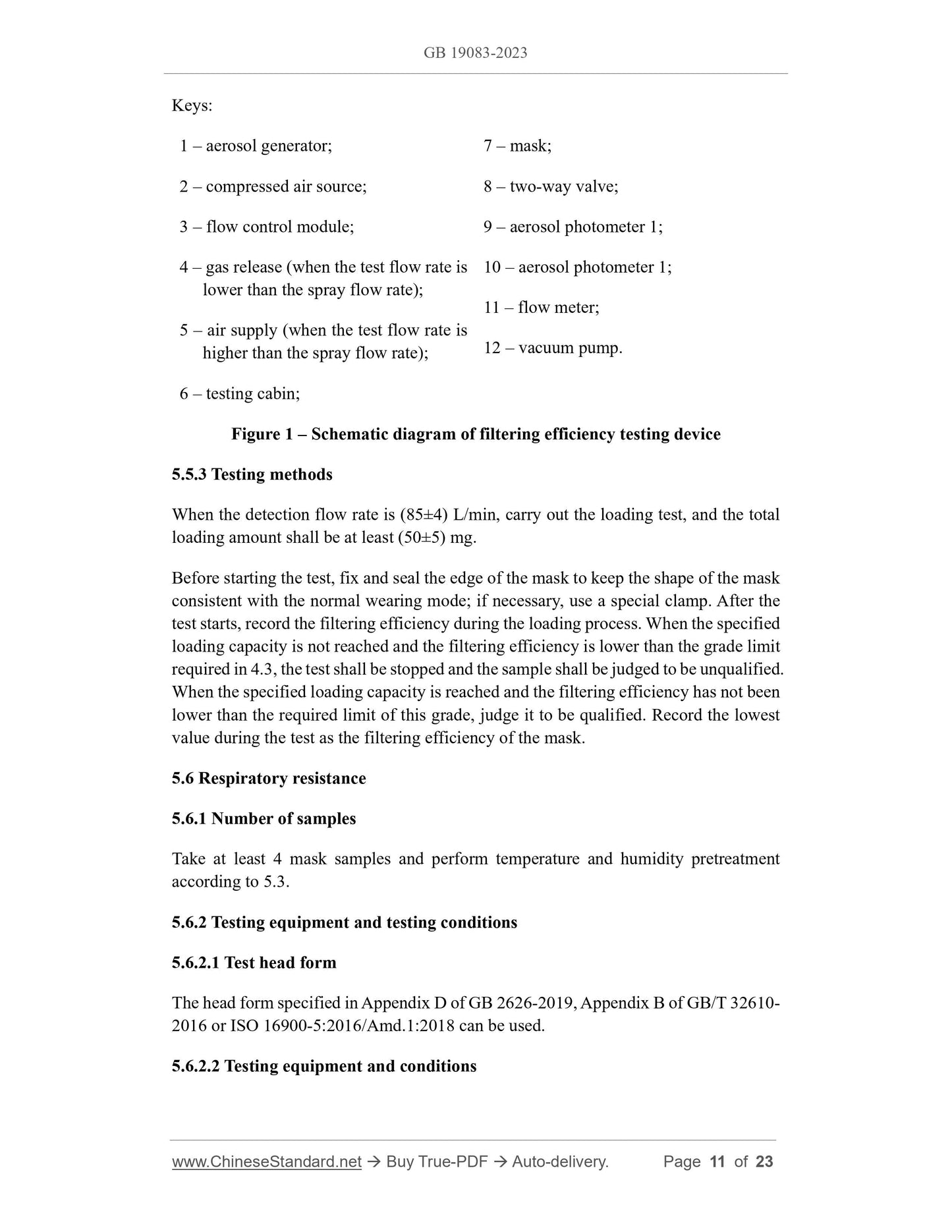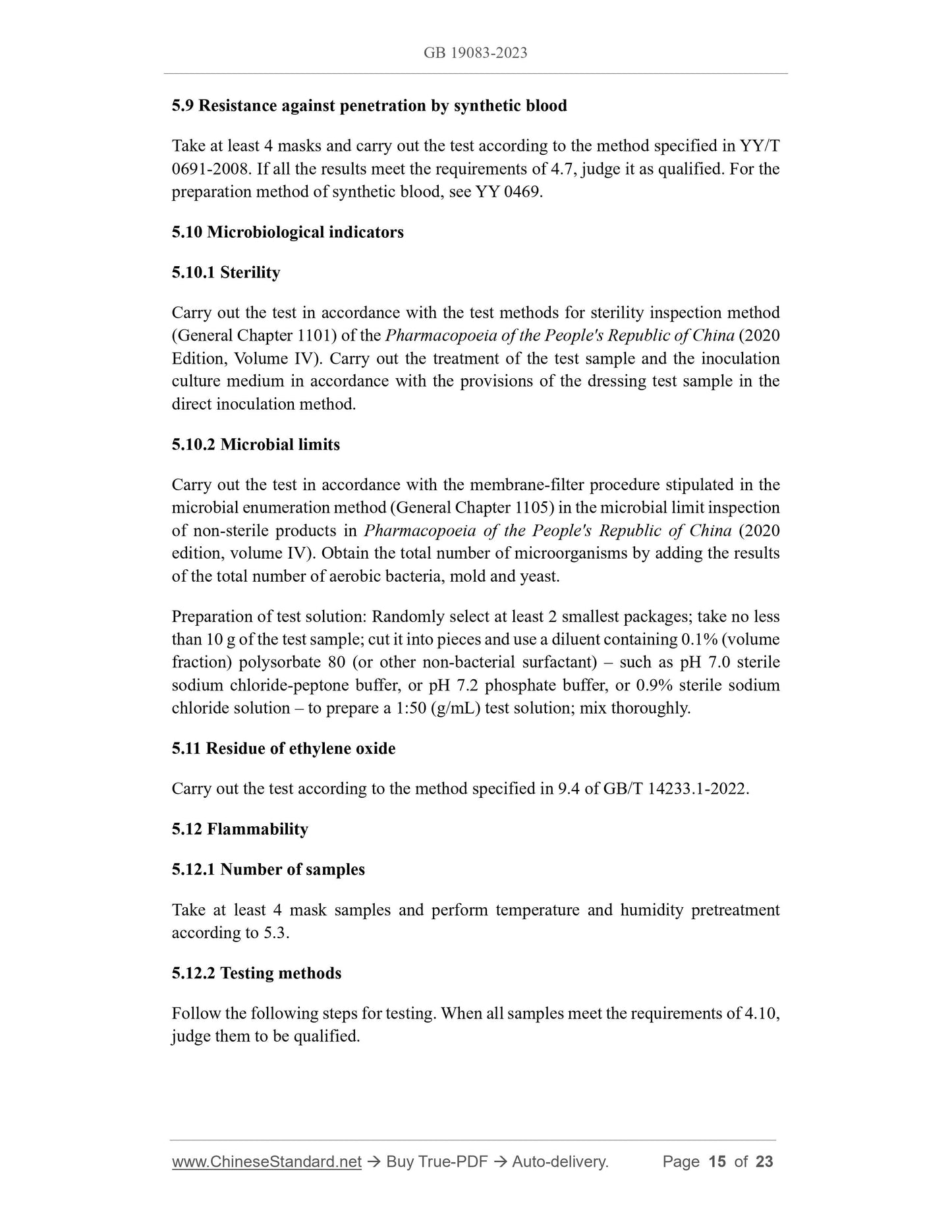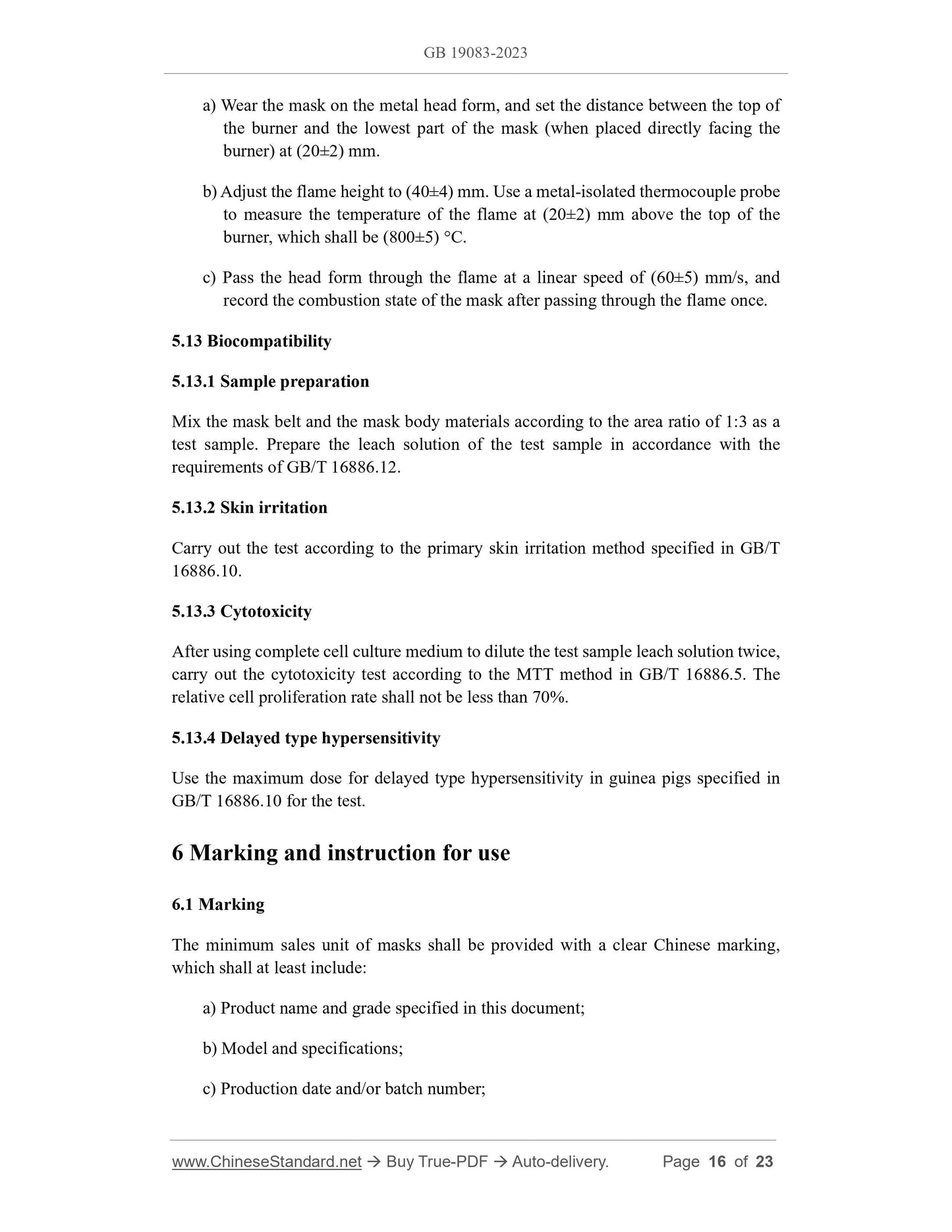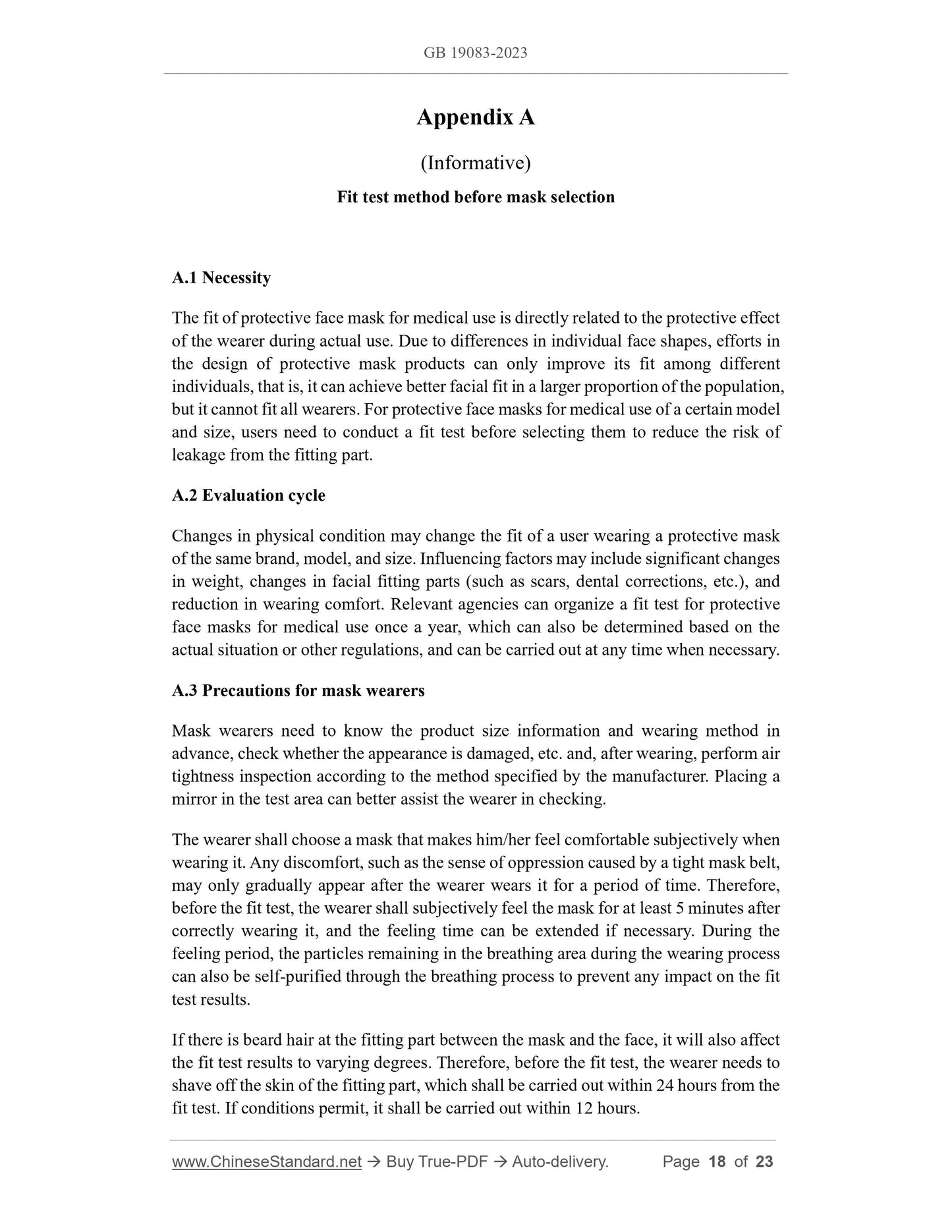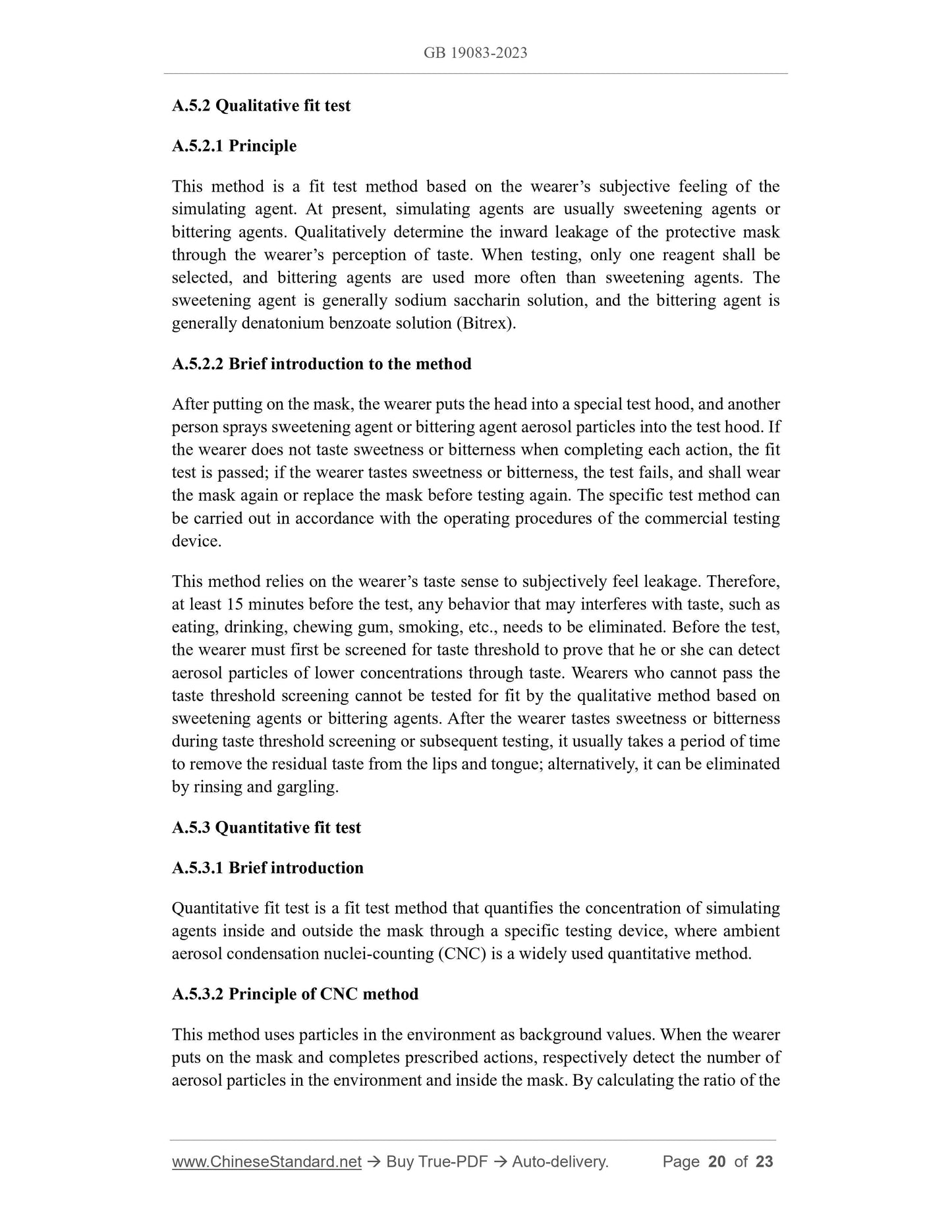1
/
of
12
PayPal, credit cards. Download editable-PDF and invoice in 1 second!
GB 19083-2023 English PDF (GB19083-2023)
GB 19083-2023 English PDF (GB19083-2023)
Regular price
$320.00 USD
Regular price
Sale price
$320.00 USD
Unit price
/
per
Shipping calculated at checkout.
Couldn't load pickup availability
Delivery: 3 seconds. Download true-PDF + Invoice.
Get QUOTATION in 1-minute: Click GB 19083-2023
Historical versions: GB 19083-2023
Preview True-PDF (Reload/Scroll if blank)
GB 19083-2023: Protective face mask for medical use
GB 19083-2023
GB
NATIONAL STANDARD OF THE
PEOPLE’S REPUBLIC OF CHINA
ICS 11.100
CCS C 44
Replacing GB 19083-2010
Protective face mask for medical use
ISSUED ON: NOVEMBER 27, 2023
IMPLEMENTED ON: DECEMBER 01, 2025
Issued by: State Administration for Market Regulation;
Standardization Administration of the People’s Republic of China.
Table of Contents
Foreword ... 4
1 Scope ... 5
2 Normative references ... 5
3 Terms and definitions ... 6
4 Requirements ... 7
4.1 Basic requirements ... 7
4.2 Mask belt connection strength ... 7
4.3 Filtration efficiency ... 7
4.4 Respiratory resistance ... 7
4.5 Dead space ... 8
4.6 Total inward leakage ... 8
4.7 Resistance against penetration by synthetic blood ... 8
4.8 Microbiological indicators ... 8
4.9 Ethylene oxide residue (if applicable) ... 8
4.10 Flammability (if applicable) ... 8
4.11 Biocompatibility... 8
5 Test methods ... 9
5.1 Test conditions ... 9
5.2 Basic requirements ... 9
5.3 Temperature and humidity pretreatment conditions ... 9
5.4 Mask belt connection strength ... 9
5.5 Filtration efficiency ... 10
5.6 Respiratory resistance ... 11
5.7 Dead space ... 13
5.8 Total inward leakage ... 14
5.9 Resistance against penetration by synthetic blood ... 15
5.10 Microbiological indicators ... 15
5.11 Residue of ethylene oxide ... 15
5.12 Flammability ... 15
5.13 Biocompatibility ... 16
6 Marking and instruction for use ... 16
6.1 Marking ... 16
6.2 Instructions for use ... 17
7 Packaging and storage ... 17
7.1 Packaging ... 17
7.2 Storage ... 17
Appendix A (Informative) Fit test method before mask selection ... 18
Bibliography ... 23
Protective face mask for medical use
1 Scope
This document specifies the requirements, markings, instructions for use, as well as
packaging and storage of disposable protective face mask for medical use (hereinafter
referred to as “face mask”), and describes the corresponding test methods.
This document is applicable to non-powered air-purifying face masks (half masks) for
filtering particles in the air and blocking droplets, blood, body fluids, secretions, etc. in
medical working environments.
This document does not apply to masks that protect against any chemical gases and
vapors.
2 Normative references
The following documents are referred to in the text in such a way that some or all of
their content constitutes requirements of this document. For dated references, only the
version corresponding to that date is applicable to this document; for undated references,
the latest version (including all amendments) is applicable to this document.
GB 2626-2019, Respiratory protection - Non-powered air-purifying particle
respirator
GB/T 14233.1-2022, Test methods for infusion, transfusion, injection equipment
for medical use - Part 1: Chemical analysis methods
GB/T 16886.5, Biological evaluation of medical devices - Part 5: Tests for in vitro
cytotoxicity
GB/T 16886.10, Biological evaluation of medical devices - Part 10: Tests for
irritation and skin sensitization
GB/T 16886.12, Biological evaluation of medical devices - Part 12: Sample
preparation and reference materials
GB/T 32610-2016, Technical specification of daily protective mask
YY 0469, Surgical mask
YY/T 0691-2008, Clothing for protection against infectious agents - Medical face
masks - Test method for resistance against penetration by synthetic blood (fixed
volume, horizontally projected)
YY/T 0866, Total inward leakage determination method of protective face mask
for medical use
Pharmacopoeia of the People’s Republic of China 2020 Edition Volume IV
ISO 16900-5:2016/Amd.1:2018, Respiratory protective devices - Methods of test
and test equipment - Part 5: Breathing machine, metabolic simulator, RPD
headforms and torso, tools and verification tools/Amendment 1: RPD head forms
front and side view
3 Terms and definitions
For the purposes of this document, the following terms and definitions apply.
3.1
filtering efficiency
The percentage of particulate matter filtered out by the mask under specified test
conditions.
3.2
dead space
The volume of air that is re-inhaled from the previous exhalation.
Note: It is expressed by the volume fraction of CO2 in the inhaled gas.
[Source: GB/T 12903-2008, 5.3.10]
3.3
total inward leakage; TIL
The ratio of the concentration of the simulated agent leaking into the mask from all
parts including the mask when the subject inhales TO the concentration of the simulated
agent in the test environment under the test conditions specified in the laboratory.
[Source: GB/T 12903-2008, 5.3.7, modified]
3.4
fit
The degree of fit between the periphery of the mask and the specific user’s face.
4.5 Dead space
The average volume fraction of CO2 in inhaled air shall not exceed 1%.
4.6 Total inward leakage
The total inward leakage shall meet the requirements in Table 1.
4.7 Resistance against penetration by synthetic blood
Spray 2 mL of synthetic blood onto the mask at a pressure of 16 kPa (120 mmHg), and
there shall be no penetration on the inside of the mask.
4.8 Microbiological indicators
4.8.1 Sterile masks shall be sterile.
4.8.2 The total number of microorganisms in non-sterile masks shall be less than or
equal to 100 CFU/g.
4.9 Ethylene oxide residue (if applicable)
If the mask has been ethylene oxide-sterilized or disinfected, its ethylene oxide residue
shall not exceed 10 μg/g.
4.10 Flammability (if applicable)
If the manufacturer expressly states that the mask material is not flammable, when
testing according to 5.12, the after-flame time shall not exceed 5 seconds.
4.11 Biocompatibility
4.11.1 Skin irritation
The primary stimulation score shall not be greater than 0.4.
4.11.2 Cytotoxicity
The relative cell proliferation rate (survival rate) shall not be less than 70%.
4.11.3 Delayed type hypersensitivity
Delayed type hypersensitivity shall not be greater than grade 1.
5 Test methods
5.1 Test conditions
Except for special requirements, the test shall be carried out in an environment with a
temperature of 16 °C ~ 32 °C and a relative humidity of (50±30)%.
5.2 Basic requirements
Randomly select at least 3 masks from 3 minimum independent packaging units,
visually inspect and actually wear them, and check whether they meet the requirements
of 4.1.
5.3 Temperature and humidity pretreatment conditions
Remove the sample packaging and perform pretreatment in the following order:
a) Place in an environment of (38±2.5) ℃ and (85±5)% relative humidity for (24±1)
h;
b) Place in a dry environment of (70±3) °C for (24±1) h;
c) Place in an environment of (-30±3) °C for (24±1) h.
The pretreatment method used should avoid thermal shock, and allow the sample
temperature to return to room temperature for at least 4 hours before subsequent
pretreatment or testing.
5.4 Mask belt connection strength
5.4.1 Number of samples
Take at least 4 mask samples and perform temperature and humidity pretreatment
according to 5.3.
5.4.2 Testing methods
Fix the main body of the mask with the outer side of the mask facing up; cut the mask
belt from the middle; let the mask belt hang naturally; apply a static pull force of 10 N
at the end for 10 seconds. The mask belt and the connection must not be disconnected.
In case of disconnection, the disconnection part (mask belt...
Get QUOTATION in 1-minute: Click GB 19083-2023
Historical versions: GB 19083-2023
Preview True-PDF (Reload/Scroll if blank)
GB 19083-2023: Protective face mask for medical use
GB 19083-2023
GB
NATIONAL STANDARD OF THE
PEOPLE’S REPUBLIC OF CHINA
ICS 11.100
CCS C 44
Replacing GB 19083-2010
Protective face mask for medical use
ISSUED ON: NOVEMBER 27, 2023
IMPLEMENTED ON: DECEMBER 01, 2025
Issued by: State Administration for Market Regulation;
Standardization Administration of the People’s Republic of China.
Table of Contents
Foreword ... 4
1 Scope ... 5
2 Normative references ... 5
3 Terms and definitions ... 6
4 Requirements ... 7
4.1 Basic requirements ... 7
4.2 Mask belt connection strength ... 7
4.3 Filtration efficiency ... 7
4.4 Respiratory resistance ... 7
4.5 Dead space ... 8
4.6 Total inward leakage ... 8
4.7 Resistance against penetration by synthetic blood ... 8
4.8 Microbiological indicators ... 8
4.9 Ethylene oxide residue (if applicable) ... 8
4.10 Flammability (if applicable) ... 8
4.11 Biocompatibility... 8
5 Test methods ... 9
5.1 Test conditions ... 9
5.2 Basic requirements ... 9
5.3 Temperature and humidity pretreatment conditions ... 9
5.4 Mask belt connection strength ... 9
5.5 Filtration efficiency ... 10
5.6 Respiratory resistance ... 11
5.7 Dead space ... 13
5.8 Total inward leakage ... 14
5.9 Resistance against penetration by synthetic blood ... 15
5.10 Microbiological indicators ... 15
5.11 Residue of ethylene oxide ... 15
5.12 Flammability ... 15
5.13 Biocompatibility ... 16
6 Marking and instruction for use ... 16
6.1 Marking ... 16
6.2 Instructions for use ... 17
7 Packaging and storage ... 17
7.1 Packaging ... 17
7.2 Storage ... 17
Appendix A (Informative) Fit test method before mask selection ... 18
Bibliography ... 23
Protective face mask for medical use
1 Scope
This document specifies the requirements, markings, instructions for use, as well as
packaging and storage of disposable protective face mask for medical use (hereinafter
referred to as “face mask”), and describes the corresponding test methods.
This document is applicable to non-powered air-purifying face masks (half masks) for
filtering particles in the air and blocking droplets, blood, body fluids, secretions, etc. in
medical working environments.
This document does not apply to masks that protect against any chemical gases and
vapors.
2 Normative references
The following documents are referred to in the text in such a way that some or all of
their content constitutes requirements of this document. For dated references, only the
version corresponding to that date is applicable to this document; for undated references,
the latest version (including all amendments) is applicable to this document.
GB 2626-2019, Respiratory protection - Non-powered air-purifying particle
respirator
GB/T 14233.1-2022, Test methods for infusion, transfusion, injection equipment
for medical use - Part 1: Chemical analysis methods
GB/T 16886.5, Biological evaluation of medical devices - Part 5: Tests for in vitro
cytotoxicity
GB/T 16886.10, Biological evaluation of medical devices - Part 10: Tests for
irritation and skin sensitization
GB/T 16886.12, Biological evaluation of medical devices - Part 12: Sample
preparation and reference materials
GB/T 32610-2016, Technical specification of daily protective mask
YY 0469, Surgical mask
YY/T 0691-2008, Clothing for protection against infectious agents - Medical face
masks - Test method for resistance against penetration by synthetic blood (fixed
volume, horizontally projected)
YY/T 0866, Total inward leakage determination method of protective face mask
for medical use
Pharmacopoeia of the People’s Republic of China 2020 Edition Volume IV
ISO 16900-5:2016/Amd.1:2018, Respiratory protective devices - Methods of test
and test equipment - Part 5: Breathing machine, metabolic simulator, RPD
headforms and torso, tools and verification tools/Amendment 1: RPD head forms
front and side view
3 Terms and definitions
For the purposes of this document, the following terms and definitions apply.
3.1
filtering efficiency
The percentage of particulate matter filtered out by the mask under specified test
conditions.
3.2
dead space
The volume of air that is re-inhaled from the previous exhalation.
Note: It is expressed by the volume fraction of CO2 in the inhaled gas.
[Source: GB/T 12903-2008, 5.3.10]
3.3
total inward leakage; TIL
The ratio of the concentration of the simulated agent leaking into the mask from all
parts including the mask when the subject inhales TO the concentration of the simulated
agent in the test environment under the test conditions specified in the laboratory.
[Source: GB/T 12903-2008, 5.3.7, modified]
3.4
fit
The degree of fit between the periphery of the mask and the specific user’s face.
4.5 Dead space
The average volume fraction of CO2 in inhaled air shall not exceed 1%.
4.6 Total inward leakage
The total inward leakage shall meet the requirements in Table 1.
4.7 Resistance against penetration by synthetic blood
Spray 2 mL of synthetic blood onto the mask at a pressure of 16 kPa (120 mmHg), and
there shall be no penetration on the inside of the mask.
4.8 Microbiological indicators
4.8.1 Sterile masks shall be sterile.
4.8.2 The total number of microorganisms in non-sterile masks shall be less than or
equal to 100 CFU/g.
4.9 Ethylene oxide residue (if applicable)
If the mask has been ethylene oxide-sterilized or disinfected, its ethylene oxide residue
shall not exceed 10 μg/g.
4.10 Flammability (if applicable)
If the manufacturer expressly states that the mask material is not flammable, when
testing according to 5.12, the after-flame time shall not exceed 5 seconds.
4.11 Biocompatibility
4.11.1 Skin irritation
The primary stimulation score shall not be greater than 0.4.
4.11.2 Cytotoxicity
The relative cell proliferation rate (survival rate) shall not be less than 70%.
4.11.3 Delayed type hypersensitivity
Delayed type hypersensitivity shall not be greater than grade 1.
5 Test methods
5.1 Test conditions
Except for special requirements, the test shall be carried out in an environment with a
temperature of 16 °C ~ 32 °C and a relative humidity of (50±30)%.
5.2 Basic requirements
Randomly select at least 3 masks from 3 minimum independent packaging units,
visually inspect and actually wear them, and check whether they meet the requirements
of 4.1.
5.3 Temperature and humidity pretreatment conditions
Remove the sample packaging and perform pretreatment in the following order:
a) Place in an environment of (38±2.5) ℃ and (85±5)% relative humidity for (24±1)
h;
b) Place in a dry environment of (70±3) °C for (24±1) h;
c) Place in an environment of (-30±3) °C for (24±1) h.
The pretreatment method used should avoid thermal shock, and allow the sample
temperature to return to room temperature for at least 4 hours before subsequent
pretreatment or testing.
5.4 Mask belt connection strength
5.4.1 Number of samples
Take at least 4 mask samples and perform temperature and humidity pretreatment
according to 5.3.
5.4.2 Testing methods
Fix the main body of the mask with the outer side of the mask facing up; cut the mask
belt from the middle; let the mask belt hang naturally; apply a static pull force of 10 N
at the end for 10 seconds. The mask belt and the connection must not be disconnected.
In case of disconnection, the disconnection part (mask belt...
Share
